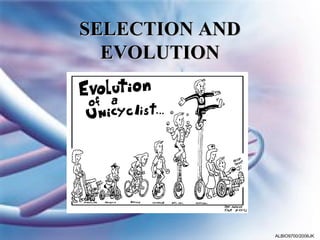
01 selection and evolution
- 1. SELECTION AND EVOLUTION ALBIO9700/2006JK
- 2. Important terms • Natural selection • Evolution • Variation • Overproduce • Allele frequencies • Isolating mechanisms • Artificial selection ALBIO9700/2006JK
- 4. 1856 Charles Darwin Alfred Wallace ALBIO9700/2006JK
- 5. Evolution • Changes within lines of descent over time • Successive changes in allele frequencies in population as brought about by occurrences such as mutation, genetic drift, gene flow, and selection pressure ALBIO9700/2006JK
- 6. NATURAL SELECTION • The way in which individuals with particular characteristics have a greater chance of survival than individuals without those characteristics, which are therefore more likely to breed and pass on the genes for these characteristics to their offspring • The strongest survive and propagate and therefore increase the strength of the species ALBIO9700/2006JK
- 7. Observation 1 • Organisms produce more offspring than are needed to replace the parents ALBIO9700/2006JK
- 8. "The elephant is reckoned the slowest breeder of all known animals, and I have taken some pains to estimate its probable minimum rate of natural increase; it will be safest to assume that it begins breeding when 30 years old and goes on breeding until 90 years old; if this be so, after a period from 740 to 750 years there would be nearly 19 million elephants descended from this first pair." – Charles Darwin ALBIO9700/2006JK
- 9. Observation 2 • Natural populations tend to remain stable in size over long periods ALBIO9700/2006JK
- 10. Observation 1 + Observation 2 Deduction 1 • There is a competition for survival (a ‘struggle for existence’) ALBIO9700/2006JK
- 11. Observation 3 • There is variation among the individuals of a given species ALBIO9700/2006JK
- 12. Deduction 1 + Observation 3 Deduction 2 • The best adapted variants will be selected for by the natural conditions operating at the time. • Natural selection occurs • The ‘best’ variants have a selective advantage; ‘survival of the fittest’ occurs ALBIO9700/2006JK
- 13. ALBIO9700/2006JK
- 14. Examples of Natural Selection Darwin identified 13 species of finches in the Galápagos Islands differing in beak size and shape ALBIO9700/2006JK
- 15. Examples of Natural Selection (cont) Natural selection was discovered among "peppered" moths living near English industrial cities ALBIO9700/2006JK
- 16. Overproduction • If left unchecked by environmental factors , numbers in a population may increase exponentially • Environmental factors i) biotic – living organisms (predation, competition for food, pathogenic infection) ii) abiotic – non-living components (water supply, soil nutrient levels) ALBIO9700/2006JK
- 17. • Natural selection keeps things the way they are – stabilising selection • Unless a new environmental factor or new allele is introduced – directional selection • Evolution occurs because natural selection gives some alleles a better chance of survival than others. Therefore, changes in allele frequency in a population are the basis of evolution . ALBIO9700/2006JK
- 18. Processes that affect allele frequencies in populations? • Malaria and sickle cell anaemia • Antibiotic resistance • Industrial melanism ALBIO9700/2006JK
